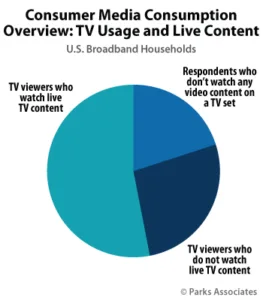Parks Associates today announced new connected entertainment research deliverables showing over 50% of U.S. broadband households now watch Internet video on a television screen. The IoT research firm examines this shift in video consumption habits of consumers, including usage of OTT services and the impact on the business of broadcast, pay TV, and online television.
“For years, the television has been the stronghold for the traditional TV industry,” said Brett Sappington, Senior Director of Research, Parks Associates. “Today, more televisions are connected to the Internet than ever, either directly or through connected devices like game consoles or streaming media players, such as Roku or Apple TV. The fact that one-half of broadband households watch Internet video on a television shows that we are well past a tipping point. The market has fundamentally changed.”
According to Parks Associates’ research:
- 88% of computer-based viewing is from non-linear sources.
- 72% of non-pay-TV subscribers subscribe to an OTT video service, which is their primary source for content.
- 49% of broadband households in the U.S. subscribe to Netflix, by far the market leader.
“Broadcasters, cable networks, and pay-TV providers have noted a decline in viewership for live, linear TV channels and a corresponding increase in on-demand viewing,” Sappington said. “The abundance of alternatives is clearly impacting the traditional TV industry. Well over 60% of households now subscribe to one or more OTT video services, and one-third subscribe to two or more services. Traditional players have taken notice and many have launched their own OTT offerings in an effort to get out in front of the shift.”
Newly released industry research available for purchase includes:
Shifting Video Consumption: Linear vs. On-Demand measures the shift in consumption from linear to on-demand across platforms and sources of content to assess how this shift will impact video and entertainment businesses in 2017 and the future.
TV Services: Changing the Channel Package examines various factors causing operators to reassess the ways in which they package their pay-TV offerings, including carriage fee battles, changing consumer preferences, new regulations, emerging technologies, and aggressive competition. The report also examines global and regional trends in video service packaging and consumer preferences related to these changes.
Digital Natives: Video Strategies for Millennials and Gen Z addresses how the Internet has changed the way young consumers watch video content. The report examines video viewing habits of millennials and provides strategic insight into building content brands that resonate with the digital-first audience.
Disruption in Live Content Consumption benefits content creators and distributors by helping them understand which consumers are shifting away from linear television and how their consumption habits are changing from traditional methods. The research analyzes the consumers who have largely moved away from linear television viewing, informing strategy for content providers and advertising partners on how to reach these audiences.
Consumers and OTT Services Business Models shows how providers in the OTT space have expanded, modified, and even discontinued different business models. The research explores consumers’ usage of OTT services with a variety of business models, examines spending on OTT services, and identifies key target markets for specific business models.

